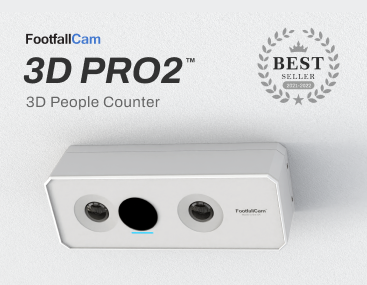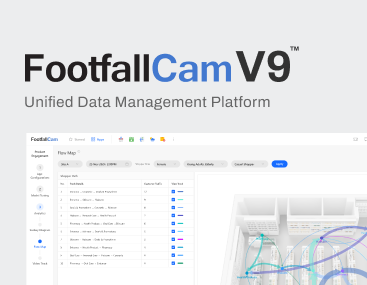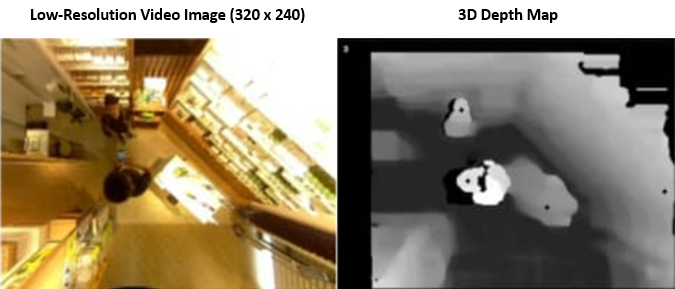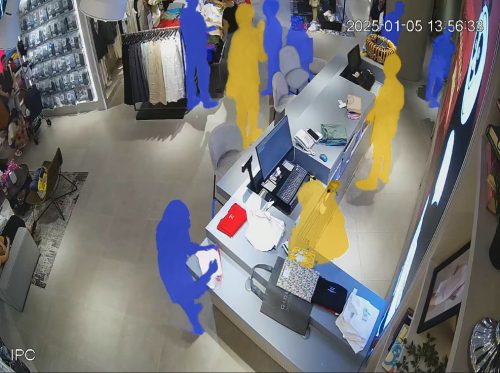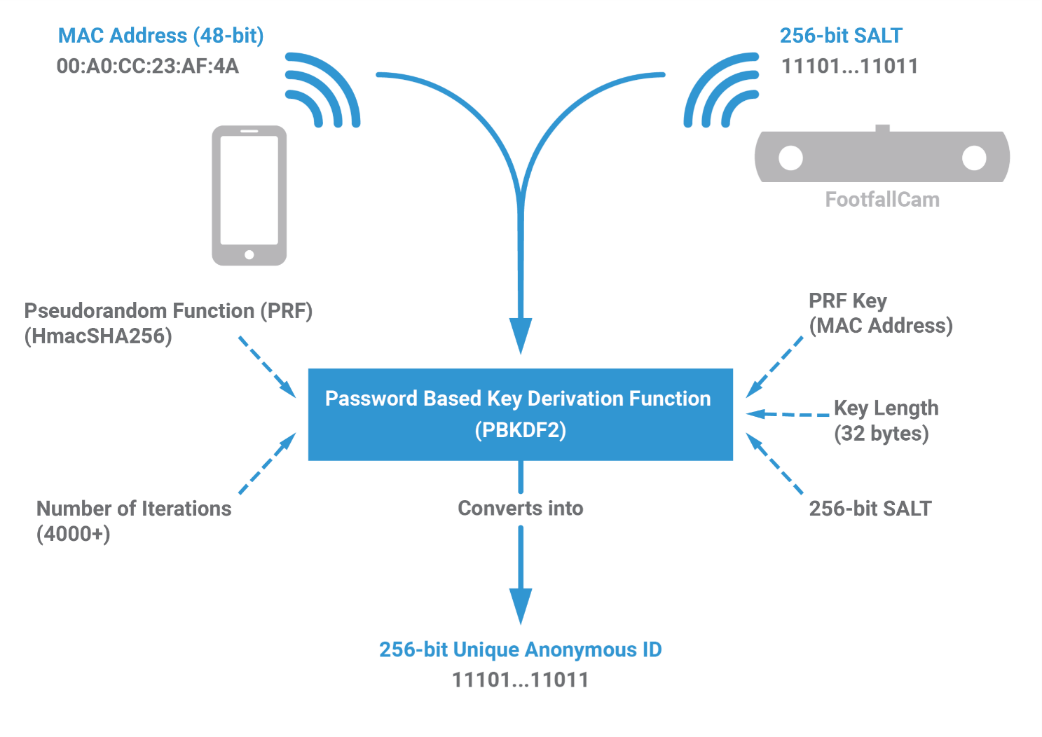| Topic | Description |
| Target Audience | FootfallCam customers who are concerned that the use of the FootfallCam system will affect their organisation's GDPR compliance. |
| Scope of the document |
|
| Notes | A GDPR exemption document for FootfallCam. |
Revision History
| Revision Number | Description of Revision | Date of Revision |
| 1 | Initial Draft | 15th June 2016 |
| 2 | Revision | 21st August 2016 |
| 3 | Initial Release | 9th February 2017 |
| 4 | Revision and Update | 20th December 2019 |
| 5 | Update of Graphics | 24th March 2020 |
1.0 The Purpose of This Article
FootfallCam uses new technologies such as 3D depth maps and Wi-Fi tracking to perform people counting activities so that our clients can plan their own business strategies based on the collected data, which is aggregated and shown in summary form. With the new technologies that are used by FootfallCam, it is natural for people to be concerned that incorporating our technologies in their retail space will give rise to the risk of exposing collected personal data, which would go against the GDPR if the data breach was not handled properly.
We put continuous effort in designing our system and data processing activities to be exempt from the GDPR by default. This does not only protect the privacy of the individual visiting the venues installed with our technologies, but also ensures that the use of the FootfallCam system does not affect our clients' GDPR compliance. The aim of this article is to explain why we only collect, store and process anonymised data instead of personal data to accomplish our objective and why we are exempt from the GDPR.
2.0 What is the GDPR and its Scope
2.1 What is the GDPR?
The General Data Protection Regulation 2016/679 is a regulation in EU law on data protection and privacy in the European Union (EU) and the European Economic Area (EEA). It also addresses the transfer of personal data outside the EU and EEA areas. It poses obligations onto organisations anywhere, as long as they target or collect data related to people in the EU. As stated in 'What is GDPR, the EU's new data protection law?' by the GDPR official authority:
...if you process the personal data of EU citizens or residents, or you offer goods or services to such people, then the GDPR applies to you even if you're not in the EU.
The primary purpose of the GDPR is to act as a standardised data protection law to protect the data privacy of EU residents and simplify the regulatory environment for international business by unifying data protection regulations within the European Union.
2.2 Types of Data in GDPR Terms
This section will explain the types of data as stated in the GDPR, which are personal data, pseudonymised data and anonymised data. It will also highlight the type of data that is collected by FootfallCam, which is the hashed Media Access Control (MAC) address, that can be categorised as anonymised data.
2.2.1 Personal data
2.2.1.1 Definition
In Article 4, Subsection 1, the GDPR states:
'personal data' means any information relating to an identified or identifiable natural person ('data subject'); an identifiable natural person is one who can be identified, directly or indirectly, in particular by reference to an identifier such as a name, an identification number, location data, an online identifier or to one or more factors specific to the physical, physiological, genetic, mental, economic, cultural or social identity of that natural person;
2.2.1.2 FootfallCam does not collect any personal data
We do not keep any Personally Identifiable Information (PII) that could potentially be used to identify a particular person during the people counting activities.
2.2.2 Pseudonymised data
2.2.2.1 Definition
In Article 4, Subsection 5, the GDPR states:
'pseudonymisation' means the processing of personal data in such a manner that the personal data can no longer be attributed to a specific data subject without the use of additional information, provided that such additional information is kept separately and is subject to technical and organisational measures to ensure that the personal data are not attributed to an identified or identifiable natural person;
2.2.2.2 Wi-Fi/Bluetooth Media Access Control (MAC) address
A MAC address is a hardware identification number that uniquely identifies each device on a network. The MAC address is manufactured into every network card, such as an Ethernet or Wi-Fi card, and therefore cannot be changed.
According to the statement from Article 4, Subsection 5, if the processing of personal data requires the use of additional information to attribute the personal data to an identified or identifiable natural person, it will be considered as 'pseudonymisation'. Although a MAC address is a unique identifier to identify the device, it is not categorised as 'personal data' because we will not be able to identify a certain individual without the use of additional information. A MAC address is tied to a device, NOT to the person. This means the MAC address does not disclose the device owner's real-world identity nor any other personal data without the use of additional information, such as the device holder's name. This means that without additional information such as the details of the SIM card and the registered account holder from the phone company (which are categorised as 'confidential information' by the phone company), it is nearly impossible to identify a certain individual with the MAC address only.
2.2.2.3 FootfallCam does not collect pseudonymised data
When you walk with your mobile device (with its Wi-Fi function enabled) into a retail space that uses our technology, FootfallCam senses the following: the presence of the device, its signal strength, its manufacturer (Apple, Samsung, etc.) and a unique identifier known as its Media Access Control (MAC) address.
The MAC address (pseudonymised data) is hashed immediately using a one-way hash function after our FootfallCam has scanned the original MAC address, turning the MAC address into anonymised data. Only the hashed values will be collected and transferred to our FootfallCam database. As we do not require the original MAC address (pseudonymised data) to achieve our objective, we DO NOT collect any pseudonymised data.
This security mechanism is applied as an additional security layer to turn the data into anonymised data that cannot be used to identify a natural person anymore. The process is irreversible as it uses a one-way hash function (for more details, please refer to 'Anonymised Data' in 'Types of data in GDPR terms').
2.2.3 Anonymised data
2.2.3.1 Definition
In Recital 26 the GDPR defines anonymised data as:
...information which does not relate to an identified or identifiable natural person or to personal data rendered anonymous in such a manner that the data subject is not or no longer identifiable.
2.2.3.2 One-way hashed MAC address & data aggregation
A one-way hash function is used to hash the MAC address, converting it into a hashed value that is irreversible. This is because the one-way hash function is designed in such a way that it is difficult to reverse the process, that is, to find the original string that has been hashed to a given value, and thus it is called 'one-way'.
Aggregated data (or data aggregation) is the process of gathering data and presenting it in a summarised format. The data may be gathered from multiple data sources with the intent of combining these data sources into a summary for data analysis, which can be useful for everything from finance or business strategy decisions, to product, pricing, operations, and marketing strategies. As the aggregated data will only be shown in a summarised format, the report should not contain any device-specific data nor individual-specific data. This allows the data aggregation technique to act as an additional security layer on top of the anonymised data to secure any collected data.
2.2.3.3 FootfallCam only collects anonymised data
FootfallCam has implemented the one-way hash technique to hash the MAC address, making it irreversible with the one-way hash and turning it into 'anonymised data'. This anonymising technique was added as an additional security layer to minimise the potential risk of exposing the MAC address that could possibly be associated to a certain individual. This technique makes it possible for FootfallCam to collect only anonymised data when achieving our objective to perform people counting activities and securing the MAC address (pseudonymised data) of a device at the same time.
Besides, we do not share any device-specific data to our clients - the retailers from whose stores the anonymous data is captured. From business and security perspectives, FootfallCam has added another measure by implementing the data aggregation techniques to summarise the information and only shows aggregated data to our clients. This ensures that, while we are able to deliver the content that our clients want effectively, the privacy of the shoppers is also protected.
2.3 Anonymised Data is Exempt from the GDPR
2.3.1 An organisation is exempt from the GDPR if they only process anonymised data
As stated in Recital 26 by the GDPR:
...The principles of data protection should therefore not apply to anonymous information, namely information which does not relate to an identified or identifiable natural person or to personal data rendered anonymous in such a manner that the data subject is not or no longer identifiable.
This Regulation does not therefore concern the processing of such anonymous information, including for statistical or research purposes.
This means, if an organisation only processes anonymised data, then they are exempt from the GDPR as anonymised data is no longer able to be used to identify the data subject. The article named Anonymisation: managing data protection risk code of practice that is provided by the Information Commissioner's Office (ICO) has further defined how anonymised data is exempt from the GDPR. As stated in the article:
There is clear legal authority for the view that where an organisation converts personal data into an anonymised form and discloses it, this will not amount to a disclosure of personal data. This is the case even though the organisation disclosing the data still holds the other data that would allow re-identification to take place. This means that the DPA no longer applies to the disclosed data, therefore:
-
there is an obvious incentive for organisations that want to publish data to do so in an anonymised form;
-
it provides an incentive for researchers and others to use anonymised data as an alternative to personal data wherever this is possible; and
-
individuals' identities are protected.
3.0 Why is FootfallCam Exempt from the GDPR?
3.1 Only Anonymised Data is Collected
3.1.1 Non-identifiable data:
-
3D depth maps for people counting activities
-
Recorded videos and low-resolution live views for accuracy audits
-
Hashed MAC addresses
3.1.2 Aggregated data, including but not limited to:
-
Number of visitors,
-
Rate of outside traffic in hourly instalments,
-
Queue counting,
-
Heatmaps,
-
Number of returning customers,
-
Occupancy rates etc.
4.0 How is FootfallCam Exempt from the GDPR?
4.0.1 Commitment to Data Privacy and Security
At FootfallCam, we are committed to ensuring the highest standards of data privacy and security in compliance with the General Data Protection Regulation (GDPR). Our technology is designed with privacy in mind, ensuring that personal identifiable information (PII) is neither collected, stored, nor processed. As a result, FootfallCam is exempt from GDPR regulations related to personal data processing, providing peace of mind to our customers and end users.
4.0.2 Why FootfallCam is Exempt from GDPR
GDPR applies to organizations that collect or process PII, including names, addresses, and biometric data. FootfallCam's system only gathers anonymized footfall data, meaning:
- No Facial Recognition: Our cameras do not store images or perform facial recognition.
- No Personal Data Stored: We only process aggregate counts, ensuring no individuals are tracked.
- No Tracking of Individuals: Our system does not create identifiable movement patterns.
As we do not handle PII, FootfallCam does not fall under the standard GDPR regulations for data controllers or processors.
4.0.3 Reassuring Customers' IT Departments
Understanding our customers' concerns about privacy and compliance, we provide complete transparency regarding our operations. To ensure GDPR compliance:
- Data Protection by Design: Our technology is engineered to avoid collecting personal data from the outset.
- Anonymization & Aggregation: Any collected data is aggregated for analytics and never linked to an individual.
- Compliance Documentation: We provide clear GDPR guidelines, ensuring customers can confidently implement FootfallCam in their businesses.
- Data Controller & Processor Guidelines: Our role as a data processor is clearly defined, and we ensure customers (data controllers) have complete control over the deployment.
4.0.4 Going Beyond GDPR Requirements
While FootfallCam is exempt from GDPR, we take extra steps to assure end-users that our solution prioritizes privacy:
- Staff Privacy Assurance: Our system is designed to avoid monitoring employees, addressing staff concerns about workplace surveillance.
- Security Protocols: We implement robust security measures, including encryption, access controls, and GDPR-aligned best practices.
- Audits & Compliance Checks: We conduct regular internal audits and provide customers with full visibility of our data handling practices.
4.0.5 How FootfallCam Can Further Strengthen GDPR Compliance
To further enhance our GDPR approach and build greater trust, we are exploring additional measures:
- Third-Party Certifications: Obtaining official certifications (such as ISO 27001) to reinforce our commitment to security.
- Transparent Privacy Policies: Offering enhanced documentation to ensure IT departments and employees have clear insights into how our system works.
- Customizable Data Retention Policies: Allowing customers to set stricter data policies to align with their internal compliance frameworks.
- Enhanced Encryption & Cybersecurity Practices: Implementing additional layers of security to further protect any collected data.
- GDPR Training for Staff & Clients: Providing resources to educate customers and their employees on privacy best practices.
4.1 Video
4.1.1 Using the 3D depth map instead of video images for counting purposes
The 3D depth map is a technology that is used in 3D computer graphics and computer vision. It is comprised of grey pixels and contains information relating to the distance of the surfaces of scene objects from a viewpoint, as shown in the right side of the diagram below:
This 3D depth map technique is used by FootfallCam to track movement and perform the counting activities, which is far more accurate than using the 2D image (as shown in the figure on the left) only.
3D depth map counting is used for the purpose of counting visitors purely in the device itself and only statistics of the visitor count will be uploaded and aggregated on the server. This process is performed to determine the amount of traffic that comes into the store only, and the aggregated data is served as statistical reports for our clients to plan business strategies. It is hardly to be recognised as identifiable data as we ONLY record the numbers of the visitor count, instead of the personal data of each individual that comes into the store. As the people counter is installed on the ceiling, it is improbable for the video to capture the entirety of consumers, nor does it recognise facial features of consumers. Please be noted that FootfallCam does not function as Closed-Circuit Television (CCTV); it only records short moments of video of up to 30 minutes, for the purpose of accuracy audits to compare manual people counting against systematic counting. The video is recorded in low resolution (320 x 240) to ensure that individuals are not identifiable, and no personal information can be gathered from it. NO videos are captured by FootfallCam afterwards to guarantee complete consumer privacy. The 3D depth map tracks the visitor count using the height of individuals entering and leaving the area only.
At FootfallCam, we prioritize data protection without compromising innovation. Our Privacy First AI framework ensures that individual privacy remains at the core of our people-counting solutions. One key feature of this approach is Privacy Masks, which provide irreversible anonymization at the source by applying real-time masking at the video stream level. This ensures that faces, clothing, and other identifiers are permanently blurred or obscured before any footage is processed or stored. Powered by AI, the system intelligently detects and anonymizes individuals while preserving essential analytics data such as visitor count and dwell time. By eliminating raw, identifiable footage, Privacy Masks facilitate compliance with privacy regulations like GDPR and CCPA, reducing the risk of data breaches or misuse. Unlike conventional AI systems that treat privacy as an afterthought, FootfallCam's technology is designed to analyze behavioral patterns rather than personal identifiers. This ensures zero storage of Personally Identifiable Information (PII) while maintaining high accuracy in people-counting and demographic analytics.
4.1.2 Low-resolution videos (320 x 240) for verification only
The FootfallCam is installed on the ceiling and facing down towards the ground so it is difficult for the video to capture the entirety of consumers, nor does it recognise facial features of consumers. However, some might still have doubts as to the chances of the passer-by's face getting recorded by the camera whenever they look up to it. The following contents will be able to answer the concerns of our clients.
4.1.2.1 Video images only appear in the Live View page for checking the camera angle, and recorded videos are for verification purpose only
Although FootfallCam has implemented the 3D depth map technique to perform the people counting activities, video images ARE NOT captured NOR stored for this counting purpose. Video images will only appear in the Live View page for checking the camera angle whereas recorded videos are for verification purposes only. FootfallCam has also taken our clients' concerns about the facial features of the data subject being recorded into consideration, which is why we have implemented the following features:
These are at a very low resolution of 320 x 240, which is classified as too low a resolution to be able to identify any individual
The video images in the Live View page are used to check whether the camera position is correct and accurate, whereas the recorded videos are used to draw the configuration line to check whether the counter is counting correctly. The collected video images and recorded videos are designed to be at a very low resolution of 320 x 240, as low-resolution images and videos are sufficient for us to carry out our objective in performing the people counting activities. As stated in Recital 26 by the GDPR:
...The principles of data protection should therefore not apply to anonymous information, namely information which does not relate to an identified or identifiable natural person or to personal data rendered anonymous in such a manner that the data subject is not or no longer identifiable.
This Regulation does not therefore concern the processing of such anonymous information, including for statistical or research purposes.
Any personal data, such as the facial features of the data subjects, that cannot be used to identify or relate to a specific person is exempt from the GDPR.
Our camera is full HD (1920 x 1080) but we are using low resolution only
Although our camera is capable of recording the video footage as full HD (1920 x 1080), we use low resolution instead because high resolution is not needed for accuracy audits and verification. Most importantly, we aim to retain the resources in real-time at a high frame rate for the 3D depth map to perform people counting activities.
4.2 Wi-Fi Tracking
4.2.1 What is it used for and how do we protect the data?
Our FootfallCam product is also equipped with Wi-Fi tracking technology to perform the people counting activities. During this time, the MAC address will be detected by FootfallCam when a mobile device (with its Wi-Fi function enabled) is nearby the retail space installed with our technologies.
As mentioned in Types of data in GDPR terms in the What is GDPR and its scope section, the original MAC address is a type of pseudonymised data as the MAC address is tied to a device, NOT to a specific person. Therefore, the MAC address alone would not be able to identify the individual without additional information to link to a person (e.g. by getting the individual personal data from the phone company - but this kind of information is classified as confidential data by the phone company). To better secure the detected MAC address, we DO NOT STORE the original MAC address in our FootfallCam device. We have implemented a one-way hash function as an additional security layer to hash the MAC address, turning it into anonymised data to protect the original MAC address.
4.2.2 How do we perform the hashing?
We have used PBKDF2WithHmacSHA256 as the hashing algorithm to hash the MAC addresses.
PBKDF2, which is also called Password-Based Key Derivation Function 2, is a key derivation function that is designed as password hashing to reduce the vulnerabilities to brute force attacks in cryptography. It applies a pseudorandom function (PRF), such as hash-based message authentication code (HMAC), to the input password or passphrase along with a SALT value and repeats the process many times to produce a derived key that can be used as a cryptographic key in subsequent operations.
This hashing algorithm is implemented into FootfallCam to secure the MAC address as shown in the diagram below:
4.2.3 Is there any way to re-identify the original MAC address?
As explained, FootfallCam has implemented Wi-Fi tracking as a technique to perform the people counting activities by tracking people's movement with their device's MAC address, and this data will be hashed and aggregated into statistical reports for our clients. Some of our clients might be concerned about the risks of the original MAC addresses being re-identified, either by reverting the hashed value to the original value or through a successful brute force attack.
4.2.3.1 It is nearly impossible to match a hashed value from 281 trillion combinations of MAC addresses
An original MAC address looks something like '00:0a:95:9d:68:16'. As explained above, FootfallCam anonymises this MAC address using the PBKDF2WithHmacSHA256 hashing algorithm to generate the anonymised MAC address which looks like 'wQIPO8yUuDT08qQpPMgLydJY+NmdQabDZVdclpejmqkg='.
This one-way hashing process is irreversible, even to FootfallCam's own employees.
The only way to guess the original MAC address from its anonymised counterpart is to find a match by brute force. There are 281 trillion combinations of MAC addresses. One will first need to put all the 281 trillion possible MAC addresses through the same hashing algorithm (and that is provided one knows the exact same SALT key), and then find the corresponding match. To put it in time perspective, a standard PC will take 10-20 centuries to make these 281 trillion tries to find the match for one original MAC address (which itself is pseudonymised data).
It is therefore reasonable to say that the possibility of re-identification is remote.
4.3 FaceCam Data Processing Principles
FootfallCam FaceCam offers state-of-the-art facial recognition capabilities, providing real-time analysis of demographic data such as age, gender, and emotion. Our data processing practices adhere to the strict requirements set forth by in General Data Protection Regulation (GDPR). All data processing activities conducted by FaceCam are conducted lawfully, based on a legitimate basis such as user consent or legitimate interests. Transparent privacy policies and consent mechanisms are implemented to inform users about the data processing activities, ensuring fairness and transparency in data handling.
4.3.1 Purpose Limitation
FaceCam strictly limits the use of facial images and associated data to the specific purpose of facial recognition and demographic analysis. This ensures that data is processed only for compatible purposes and not used for any other undisclosed or incompatible purposes.
4.3.2 Data Minimization
FaceCam employs data minimization techniques to collect and transmit only the minimum amount of personal data necessary for its intended purposes. While facial images are captured by the device, only anonymized demographic data is transmitted to the server for further analysis, minimizing the risk of processing unnecessary personal data.
4.3.3 Accuracy and Retention
Measures are implemented to ensure the accuracy of facial recognition and demographic analysis results generated by FaceCam. Additionally, retention policies are in place to delete or anonymize personal data once it is no longer necessary for the intended purposes, reducing the risk of retaining personal data beyond its lawful retention period.
4.3.4 Security Measures
FaceCam incorporates robust security measures to protect personal data during transmission and storage on the server side. Advanced encryption algorithms, access controls, secure transmission protocols (i.e., HTTPS), and regular security assessments are implemented to safeguard against unauthorized access, disclosure, or tampering of personal data.
5.0 The Risk of Identification is Remote
According to the Information Commissioner's Office of the UK (ICO), The Data Protection Act 'does not require anonymisation to be completely risk free - you must be able to mitigate the risk of identification until it is remote.'
5.1 It is Nearly Impossible to Identify the Person Using Low-Resolution Video
As the collected video images and recorded videos are designed to be at a very low resolution of 320 x 240, it is nearly impossible to identify or recognise the facial features of an individual, not to mention that the counter is installed on the ceiling and facing down towards to the ground.
5.2 Re-Identification of the Original MAC Address (Pseudonymised Data) is Nearly Impossible
A one-way hash function is used to hash the original MAC address into a hashed value. As its name suggests, this function only allows the original value to be hashed into an anonymised hashed value and this process is irreversible. With the current technologies, the only possibility to match the hashed value is to perform a brute force attack on the 281 trillion combinations of MAC addresses along with the same hashing algorithm and SALT value. As the hashing algorithm that we have used, which is PBKDF2WithHMacSHA256, is designed to reduce the vulnerabilities to the brute force attack (and there are a total of 281 trillion MAC addresses which might take 10-20 centuries to find an exact match), it has greatly reduced the possibilities of the original MAC address being re-identified.
6.0 DPIA is Unnecessary According to ICO Checklist
According to the ICO checklists, FootfallCam does not require a Data Protection Impact Assessment (DPIA) as we only process anonymised data. DPIA is an assessment to help with identifying and minimising the data protection risks of a project. It is a key part of your accountability obligations under the GDPR. The DPIA which, when done properly, can help to assess and demonstrate how to comply with the data protection obligations. A DPIA must be done for processing that is likely to result in a high risk to individuals. The ICO has provided an official DPIA screening checklist as a resource to decide whether to do a DPIA. The ICO has also provided a DPIA awareness checklist as a standard to ensure that the organisation's relevant employees are well aware of the DPIA and are trained to conduct a DPIA if necessary. We put in continuous effort in designing a system that not only complies with the current regulations in place, but also goes beyond in ensuring the privacy of the individuals visiting the venues installed with our technologies. FootfallCam is aware of the need for a DPIA.
However, it is proven that our processing does not require a DPIA after completing the checklists provided by the ICO, which are the DPIA Awareness Checklist and the DPIA Screening Checklist. For more details, please refer to the DPIA Awareness Checklist and DPIA Screening Checklist below.
6.1 DPIA Awareness Checklist
We will also ensure that our relevant staff have the resources and awareness to identify the need of a DPIA for our products. |
6.2 DPIA Screening Checklist
We are not involved in any of the activities stated above as our FootfallCam data processing activities do not need to process any of the individual's personal data.
None of the activities above are in line with the FootfallCam product as FootfallCam only collects and processes anonymised data during the data processing activities.
Based on the DPIA Screening Checklist, we do not fulfil any of the data processing activities stated above. This is because we do not collect or process the personal data of any individual. Instead, we only store and process anonymised data to accomplish our objective. As stated in Recital 26 by the GDPR: ...The principles of data protection should therefore not apply to anonymous information, namely information which does not relate to an identified or identifiable natural person or to personal data rendered anonymous in such a manner that the data subject is not or no longer identifiable. This Regulation does not therefore concern the processing of such anonymous information, including for statistical or research purposes. At the present stage, our FootfallCam product does not require a DPIA because only anonymised data is processed instead of personal data. However, FootfallCam still follows rules to achieve data minimisation and implements security mechanisms to ensure the risk of identification is able to be mitigated until it is remote. FootfallCam will review our data processing activities periodically, especially when introducing a new data processing procedure, to ensure we are able to secure the privacy of the data subject while accomplishing our objectives at the same time. If we find out that our new data processing activities are involved in the scope of the DPIA Screening Checklist, we will take action to ensure it is compliant with the GDPR and carry out a DPIA if necessary. |
7.0 Future Updates
Our Privacy Statement may vary from time to time and all updates will be posted on this page if any changes are made. This statement is maintained and reviewed periodically to reflect the updated privacy laws and GDPR compliance. The FootfallCam Data Protection Officer is responsible for the accuracy and maintenance of this policy. If you have any questions or enquiries regarding our Privacy Policy, kindly send us an email at [email protected]

